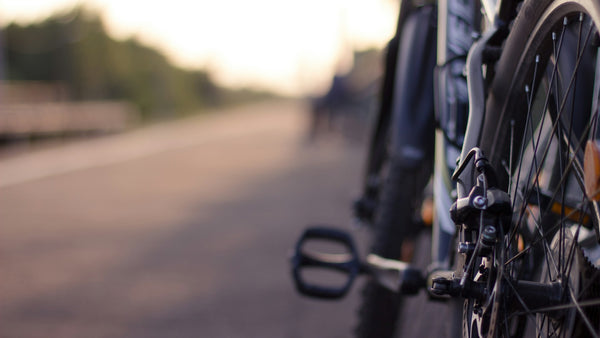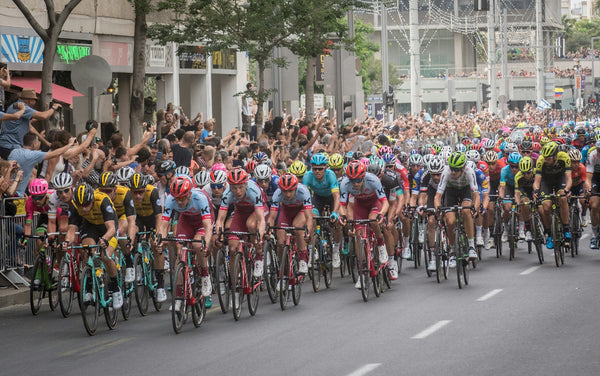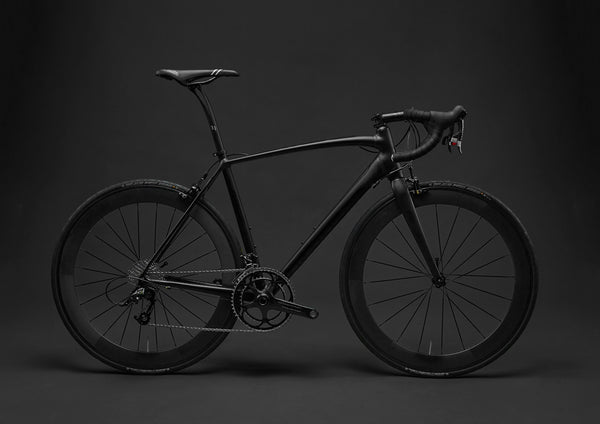In professional road cycling, there are three Grand Tours: the Tour de France, the Giro d’Italia and the Vuelta a Espana. Grand Tours by definition are three weeks long and they are the only races on the yearly racing calendar that are this long.
Of the three, without question the most important race is the Tour de France. Not only because it is probably the only cycling race your non-cycling friends and family have ever heard of, but because just to race it can be the pinnacle of any pro rider’s career. And to win a stage can define a career. To win a Tour de France overall is something only the best of the best can hope to achieve.
But what about all the other races? Aren’t they important? Of course they are. Not every rider has the capability to win a Grand Tour. Someone like current World Champion Mathieu van der Poel is a hugely talented rider, able to win races from January through December (including cyclocross). But he will never win a Tour de France largely because he is what is called a “classics specialist” or a larger rider who is physiologically unable to climb the high mountains as fast as would be necessary to be considered a contender at a Grand Tour, or even smaller one-week races like the Tour de Suisse or Critérium du Dauphiné.
Dividing up the cycling racing calendar
The racing season is broken up into different focal points throughout the year to allow riders to target those races that suit their strengths. The early season starts already in January with events in Australia and the Middle East. But for our money, the first really exciting race of the season comes in early March with Strade Bianche.
The race around the white roads of Tuscany can frequently point out not only which of the classics specialists but also which of the Grand Tour experts have had the best preseason preparation. It marks the start of real spring racing and treats the viewer to spectacular views across the hills of the Crete Senesi in Tuscany south of Siena. And perhaps only the Tour de France’s finish in the Champs Elysée and Paris-Roubaix’s finale in the Roubaix velodrome can trump Strade Bianche dramatic climb up to and finish in Siena’s historic Piazza del Campo.
From Strade Bianche, most of the peloton will neatly segue into Tirreno Adriatico, the first Italian stage race of the season. Paris-Nice, the opening French stage race, starts the day after Strade, which usually means most riders racing in Italy will not start in Paris the next day. These two important stage races run more or less concurrently, which helps divide up the peloton into riders probably targeting Milan Sanremo (those racing Tirreno) and riders looking to get a first look potentially at some Tour de France stage routes that the ASO, organizers of the Tour, may pepper throughout the week-long French stage race. Considering the 2024 Tour will finish for the first time in its history in Nice, and the final dramatic weekend will cover many of the same roads as Paris-Nice, it wouldn’t be surprising to see many of the top professionals who fancy their chances at the Tour to be racing in France instead of Italy during that week in March.
In mid-March, Milan-Sanremo is the first and longest Monument on the calendar. There are five official Monuments, a term that has been coined in the last 25 to 30 years to indicate the enormous importance of these one-day races that highlight the racing season. Milan-Sanremo typically covers 300 kilometers (~185 miles) racing from the center of Milan (normally) through the rice fields of Lombardy, over the hills that separate Piemonte from Liguria, down to Genoa and along the Ligurian coast in the direction of France till they reach Sanremo right on the Mediterranean Sea.
Spring Highlight: the cobbled and Ardennes classics
Once March is well underway, that means racing in the north of France and in Belgium takes center stage with the cobbled classics and semi-classics. These are races like E3 Classic and Gent-Wevelgem that are prestigious to win in themselves, but also act as precursors and testing grounds for the marquee cobbled classics: the Tour of Flanders and Paris-Roubaix in early April. As the next two Monuments on the calendar, these are races every pro dreams of racing and even winning.
As important as those races are – and certain riders like Mathieu van der Poel or Tom Pidcock might plan their entire seasons around the “Holy Week” that covers the Flanders/Roubaix events – there is hardly time to breathe before the Ardennes Classics take everyone’s attention. The main events of this important period include the “Triple Crown” of Amstel Gold, Flèche Wallone, and the fourth Monument of the season, Liège-Bastogne-Liège. Again, only the best riders in the world can hope to win any of these three races, and Liège frequently is the first showdown among the three or four riders who have a legitimate hope of winning the Tour de France.
The first Grand Tour of the season
Many purists love the Giro d’Italia above all races because it is the Grand Tour that can still create race images and situations similar to the days before modern racing styles and sciences. That’s largely because the Giro, and in particular the mountain stages, come early enough in the year to face the danger of seriously terrible weather. Rain, winds, and even snow can plague the riders and the organizer, but charm the fans with the images of suffering and perseverance.
Though the Giro may not objectively be the most important race of the season, it comes very close, and is often the race that certain elite riders will base their season around. In 2024 someone as top drawer as Wout Van Aert is said to be basing his season around the Giro, and may even focus on winning it, in spite of the fact that he fits very easily into the same category of rider as Van Der Poel. But Van Aert has proved in the past that he has the ability to climb, time trial, and protect himself throughout the course of three weeks. With the 2024 Giro being unusually rich in time trial miles, Van Aert can legitimately hope to be in the mix at the top of the leaderboard, provided he has an optimum build-up to the race.
Building-up to the Tour
Once the Giro is finished, then inevitably most thoughts turn to the Tour de France and the very important preparatory pre-races. Similarly to the beginning of the season when Paris-Nice and Tirreno-Adriatico overlap, the Critérium du Dauphiné and the Tour de Suisse click heels over one weekend, which means that a rider must choose between the two in the course of their pre-Tour build-up.
Both races are equally important. The Dauphiné has the advantage of taking place mostly the week before Suisse, which allows for a week more recovery time before the Tour starts. It will also often cover some of the more important Alpine climbs that the Tour will later face, giving the riders invaluable experience ahead of the Tour. But the Tour de Suisse has its advantages too, since the racing can be less stressful under the calmer Swiss conditions and without the pressure cooker atmosphere that can develop in France in these pregnant weeks ahead of the Tour de France.
No matter which of the two you race, winning either is a huge accomplishment for even the most successful riders; Primoz Roglic understands this, which is why for 2024, he has stated that he’d like to win the Tour de Suisse, which is the only major non-Grand Tour stage race that he has not yet won.
Le Tour
Aside from the national road and time trial championships that typically take place in Europe the week before the start of the Tour, after Suisse finishes, all eyes turn to France. The month of July is pretty much dominated by the Tour. It is the most important race on the calendar and every professional wants to race it at least once in his career.
In 2024, the Tour will have a unique feel since it will notably be starting in Florence and finishing in Nice. The traditional final stage in Paris on the Champs will not be possible on account of the activities around the Paris Olympics. It will make for a fantastic event that will favor all-rounders as much as it does climbers.
When asking what is the most important road cycling race in the world, there is only one answer: the Tour de France. But when asking why, that is less easy to answer. Though first raced in 1903, it is not the oldest race in the world. Though three weeks long, it is not necessarily the longest race in the world. Though it takes in both the Alps and the Pyrenees along with other smaller mountain ranges like the Voges, Jura, and Massif Central, it typically isn’t the race with the most climbing. Yet, it nevertheless is unequivocally, undeniably the most important cycling race in the world.
Post-Tour doldrums
In 2024 at least, the post-Tour doldrums won’t last long since the week after the race finishes on July 21st, the Olympic men’s time trial will take place in Paris with the road race to follow on August 3rd. The flat profile means that the winner of the Tour will unlikely be the winner of the Olympics, but with the route in and around Paris, it will certainly be a pleasure to watch and interesting to see how the race unfolds.
That will be followed by a handful of other smaller events that will help lead us up to the third and final Grand Tour of the season, the Vuelta a Espana. It is unfair to say that the Vuelta is the least prestigious of the three Grand Tours, since to win any three week race is a huge accomplishment. And the Vuelta has the reputation of being the most climbing-heavy and difficult to win of the three. Coming later in the season, things like form and motivation can also cause problems since bodies are getting tired and minds even more fatigued.
Thanks to its place on the calendar, the Vuelta can serve as a useful redemption race for any riders who targeted the Tour de France and failed to live up to expectations, for whatever reasons. Its reputation as the last chance saloon for the Grand Tour season gives it a playful, no-holds-barred atmosphere which makes it one of the more unpredictable races of the season. Just think back to 2023 when American hero Sepp Kuss won ahead of his teammates in spite of the two teammates attacking him on some of the hardest climbs.
For 2024, we can expect to see Sepp back and in top form ready to defend his title. We can also hope to see Egan Bernal back to his best since he has announced that his main goal for the year will be to race the Vuelta to challenge for the win, which would complete his collection of Grand Tour collection since he already has the Tour and the Giro on his palmarès.
Worlds and Il Lombardia closing out the season
Though there are only five Monuments, there is also the World Championships which might outweigh all the Monuments thanks to the fact that the World Champion has the honor of wearing the distinctive rainbow jersey for the next year. For 2024, the race will take place in Zurich, Switzerland, and promises to be an exciting course thanks to the amount of climbing which will be difficult but still manageable for heavier riders with a fast finish..
That means punchy climbers who have a good sprint should shine. Maybe it will be Tadej Pogacar’s best chance to win the rainbow jersey. Or perhaps Remco Evenepoel will be able to retake the jersey he lost in Glasgow. The scenery should be spectacular, especially if we can count on the Zurich summer weather to hold through late September.
And whoever takes the rainbow bands in Zurich will likely also be a top contender for the final Monument of the season, Il Lombardia or the Tour of Lombardy. Perhaps the most consistently beautiful race on the calendar, it takes place between Como and Bergamo around the northern lakes of Italy. It is most definitely a climber’s classic, highlighted by the fact that Pogacar has won it the past three years in a row. Can he make it four in 2024?
Grand tours of cycling - Conclusion
Even if the Tour de France is undeniably the most important race on the professional road calendar, that doesn’t mean the other races do not have their own place in the grand scheme of things. And for riders who cannot with the Tour, their most important races personally might be completely different. For cobbled classic racers, perhaps Flanders or Roubaix is most important. For time trialists, winning Worlds or the Olympic time trials might be the biggest success of their careers.
As much as certain cycling pundits like to complain about the hodge-podge mish-mash of the cycling calendar, the width and breadth of events across basically 11 months gives all sorts of riders all sorts of chances to race, improve, and win. It’s a crazy, convoluted sport, but that’s one of the reasons we love it so much.
Be sure to also check our article on Tour de France Femmes.



































































































































































































































































